Multi-Year Continuous PM2.5 Measurements with the Federal Equivalent Method SHARP 5030 and Comparisons to Filter-Based and TEOM Measurements in Ontario, Canada
Abstract
:1. Introduction
2. Methods
2.1. Ambient Air Monitoring Network in Ontario, Canada
2.2. The SHARP 5030
2.3. Integrated Measurements
2.4. The TEOM
2.5. Data Treatment
3. Results and Discussion
3.1. Field Performance of the SHARP 5030
3.2. Comparison between the SHARP 5030 and the FRM
3.3. Comparison between the SHARP 5030 and the TEOM
4. Conclusions
Author Contributions
Acknowledgments
Conflicts of Interest
References
- Brunekreef, B.; Holgate, S.T. Air pollution and health. Lancet 2002, 360, 1233–1242. [Google Scholar] [CrossRef]
- Pope, C.A.; Ezzati, M.; Dockery, D.W. Fine-particulate air pollution and life expectancy in the United States. N. Engl. J. Med. 2009, 360, 376–386. [Google Scholar] [CrossRef] [PubMed]
- Atkinson, R.W.; Kang, S.; Anderson, H.R.; Mills, I.C.; Walton, H.A. Epidemiological time series studies of PM2.5 and daily mortality and hospital admissions: A systematic review and meta-analysis. Thorax 2014, 69, 660–665. [Google Scholar] [CrossRef] [PubMed]
- Kim, K.-H.; Kabir, E.; Kabir, S. A review on the human health impact of airborne particulate matter. Environ. Int. 2015, 74, 136–143. [Google Scholar] [CrossRef] [PubMed]
- Lu, F.; Xu, D.; Cheng, Y.; Dong, S.; Guo, C.; Jiang, X.; Zheng, X. Systematic review and meta-analysis of the adverse health effects of ambient PM2.5 and PM10 pollution in the Chinese population. Environ. Res. 2015, 136, 196–204. [Google Scholar] [CrossRef] [PubMed]
- Loomis, D.; Grosse, Y.; Lauby-Secretan, B.; El Ghissassi, F.; Bouvard, V.; Benbrahim-Tallaa, L.; Guha, N.; Baan, R.; Mattock, H.; Straif, K.; et al. The carcinogenicity of outdoor air pollution. Lancet Oncol. 2013, 14, 1262–1263. [Google Scholar] [CrossRef]
- Ministry of the Environment and Climate Change (MOECC). Air Quality in Ontario 2015 Report; Queen’s Printer for Ontario: Toronto, ON, Canada, 2017; ISSN 1710-8136. [Google Scholar]
- Gillies, J.A.; Gertler, A.W.; Sagebiel, J.C.; Dippel, W.A. On-road particulate matter (PM2.5 and PM10) Emissions in the Sepulveda Tunnel, Los Angeles, California. Environ. Sci. Technol. 2001, 35, 1054–1063. [Google Scholar] [CrossRef] [PubMed]
- Kim, E.; Hopke, P.K.; Edgerton, E.S. Source identification of Atlanta aerosol by positive matrix factorization. J. Air Waste Manag. Assoc. 2003, 53, 731–739. [Google Scholar] [CrossRef] [PubMed]
- Begum, B.A.; Kim, E.; Jeong, C.H.; Lee, D.W.; Hopke, P.K. Evaluation of the potential source contribution function using the 2002 Quebec forest fire episode. Atmos. Environ. 2005, 39, 3719–3724. [Google Scholar] [CrossRef]
- Sofowote, U.M.; Su, Y.; Dabek-Zlotorzynska, E.; Rastogi, A.K.; Hopke, P.K. Sources and temporal variations of constrained PMF factors obtained from multiple-year receptor modeling of ambient PM2.5 data from five speciation sites in Ontario, Canada. Atmos. Environ. 2015, 108, 140–150. [Google Scholar] [CrossRef]
- Healy, R.M.; Sofowote, U.; Su, Y.; Debosz, J.; Noble, M.; Jeong, C.H.; Wang, J.M.; Hilker, N.; Evans, G.J.; Doerksen, G.; et al. Ambient measurements and source apportionment of fossil fuel and biomass burning black carbon in Ontario. Atmos. Environ. 2017, 161, 34–47. [Google Scholar] [CrossRef]
- Tucker, W.G. An overview of PM2.5 sources and control strategies. Fuel Process. Technol. 2000, 65–66, 379–392. [Google Scholar] [CrossRef]
- Zheng, M.; Cass, G.R.; Schauer, J.J.; Edgerton, E.S. Source apportionment of PM2.5 in the southeastern United States using solvent-extractable organic compounds as tracers. Environ. Sci. Technol. 2002, 36, 2361–2371. [Google Scholar] [CrossRef] [PubMed]
- Dabek-Zlotorzynska, E.; Dann, T.F.; Martinelango, P.K.; Celo, V.; Brook, J.R.; Mathieu, D.; Ding, Y.; Austin, C.C. Canadian National Air Pollution Surveillance (NAPS) PM2.5 speciation program: Methodology and PM2.5 chemical composition for the years 2003–2008. Atmos. Environ. 2011, 45, 673–686. [Google Scholar] [CrossRef]
- Patashnick, H.; Rupprecht, E.G. Continuous PM10 measurements using the tapered element oscillating microbalance. J. Air Waste Manag. Assoc. 1991, 41, 1079–1083. [Google Scholar] [CrossRef]
- United States Environmental Protection Agency (US EPA). List of Designated Reference and Equivalent Methods; National Exposure Research Laboratory, Human Exposure & Atmospheric Sciences Division: Research Triangle Park, NC, USA, 2011.
- Zhu, K.; Zhang, J.; Lioy, P.J. Evaluation and Comparison of Continuous Fine Particulate Matter Monitors for Measurement of Ambient Aerosols. J. Air Waste Manag. Assoc. 2007, 57, 1499–1506. [Google Scholar] [CrossRef] [PubMed]
- Motallebi, N.; Taylor, C.A., Jr.; Turkiewicz, K.; Croes, B.E. Particulate matter in California: Part 1—intercomparison of several PM2.5, PM10-2.5, and PM10 monitoring networks. J. Air Waste Manag. Assoc. 2003, 53, 1509–1516. [Google Scholar] [CrossRef] [PubMed]
- Rizzo, M.; Scheff, P.A.; Kaldy, W. Adjusting tapered element oscillating microbalance data for comparison with Federal Reference Method PM2.5 measurements in Region 5. J. Air Waste Manag. Assoc. 2003, 53, 596–607. [Google Scholar] [CrossRef] [PubMed]
- Tortajada-Genaro, L.-A.; Borrás, E. Temperature effect of tapered element oscillating microbalance (TEOM) system measuring semi-volatile organic particulate matter. J. Environ. Monit. 2011, 13, 1017–1026. [Google Scholar] [CrossRef] [PubMed]
- Hsu, Y.-M.; Wang, X.; Chow, J.C.; Watson, J.G.; Percy, K.E. Collocated comparisons of continuous and filter-based PM2.5 measurements at Fort McMurray, Alberta, Canada. J. Air Waste Manag. Assoc. 2016, 66, 329–339. [Google Scholar] [CrossRef] [PubMed]
- Charron, A.; Harrison, R.M.; Moorcroft, S.; Booker, J. Quantitative interpretation of divergence between PM10 and PM2.5 mass measurement by TEOM and gravimetric (Partisol) instruments. Atmos. Environ. 2004, 38, 415–423. [Google Scholar] [CrossRef]
- Chow, J.C.; Watson, J.G.; Lowenthal, D.H.; Chen, L.-W.A.; Tropp, R.J.; Park, K.; Magliano, K.A. PM2.5 and PM10 mass measurements in California’s San Joaquin Valley. Aerosol Sci. Technol. 2006, 40, 796–810. [Google Scholar] [CrossRef]
- The Office of the Federal Register. 40 CFR Parts 53 and 58: Revisions to Ambient Air Monitoring Regulations—Final Rule; 71 FR 61236-61328; Office of the Federal Register: College Park, MD, USA, 2006.
- Sofowote, U.; Su, Y.; Bitzos, M.M.; Munoz, A. Improving the correlations of ambient tapered element oscillating microbalance PM2.5 data and SHARP 5030 Federal Equivalent Method in Ontario: A multiple linear regression analysis. J. Air Waste Manag. Assoc. 2014, 64, 104–114. [Google Scholar] [CrossRef] [PubMed]
- Kennedy, J.B.; Neville, A.M. Basic Statistical Methods for Engineers & Scientists, 2nd ed.; Thomas Y. Crowell Company: New York, NY, USA, 1976; ISBN 0-7002-2480-7. [Google Scholar]


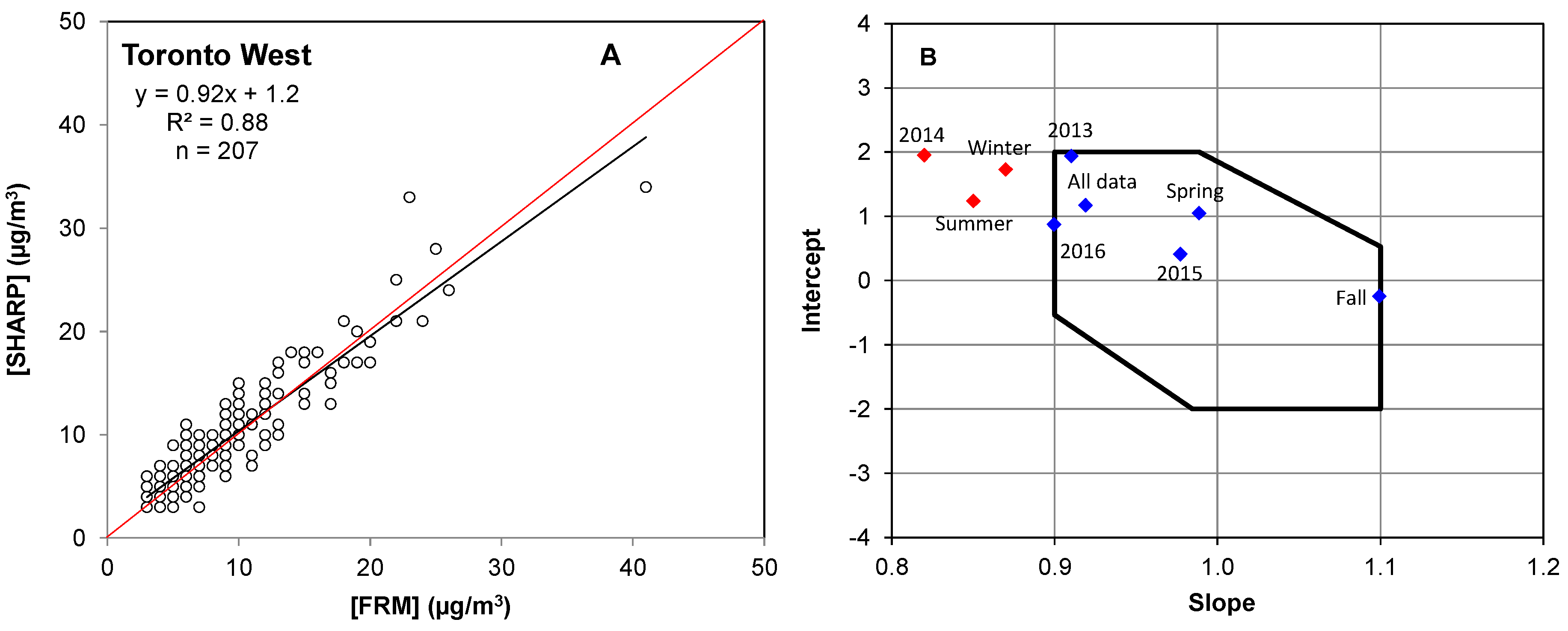
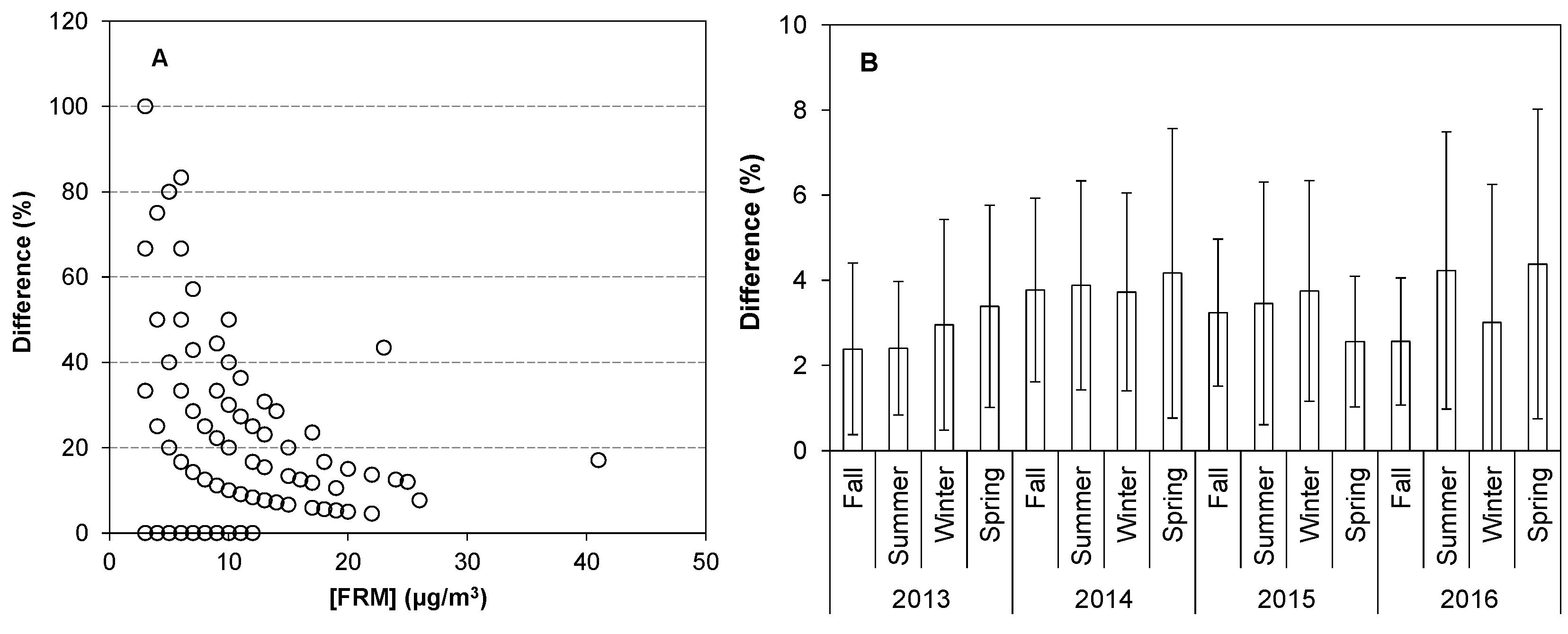
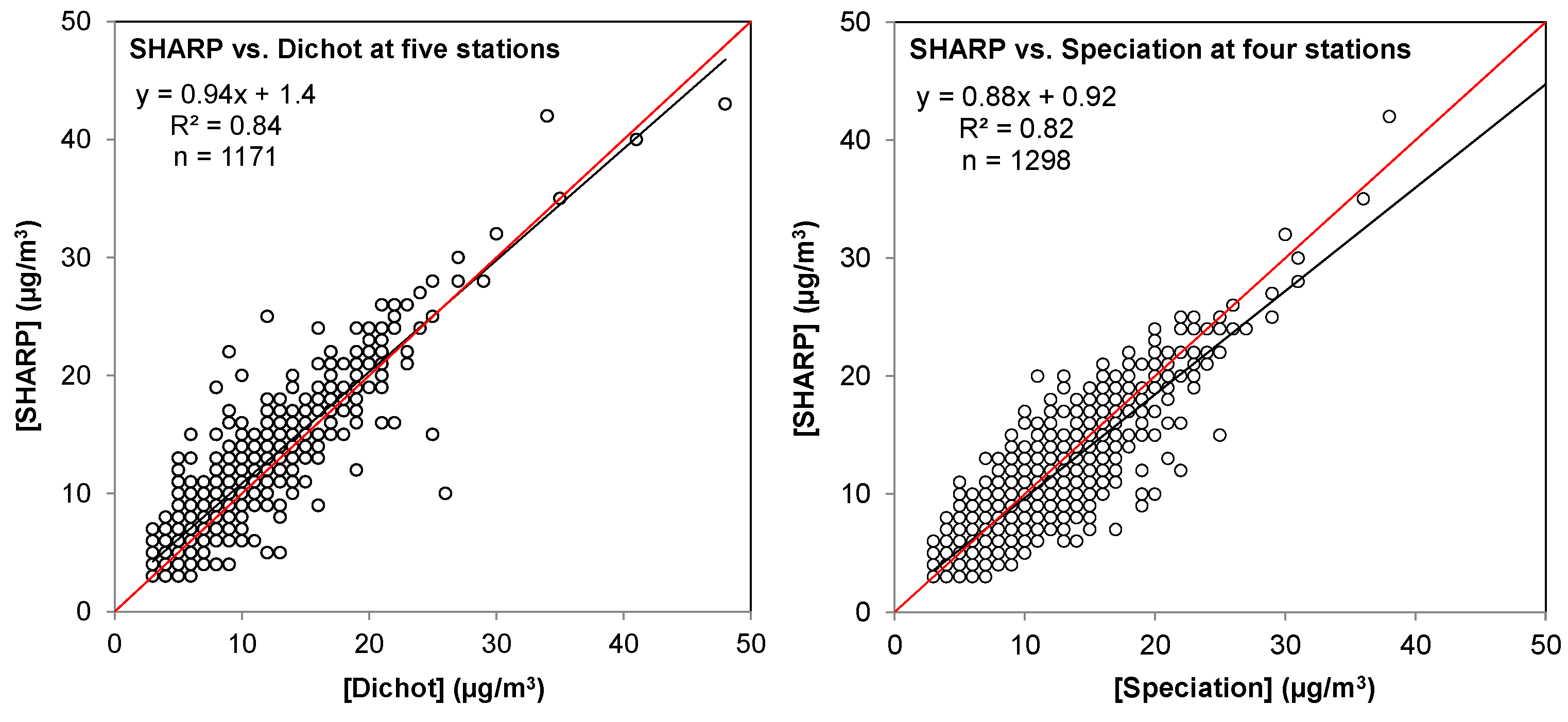

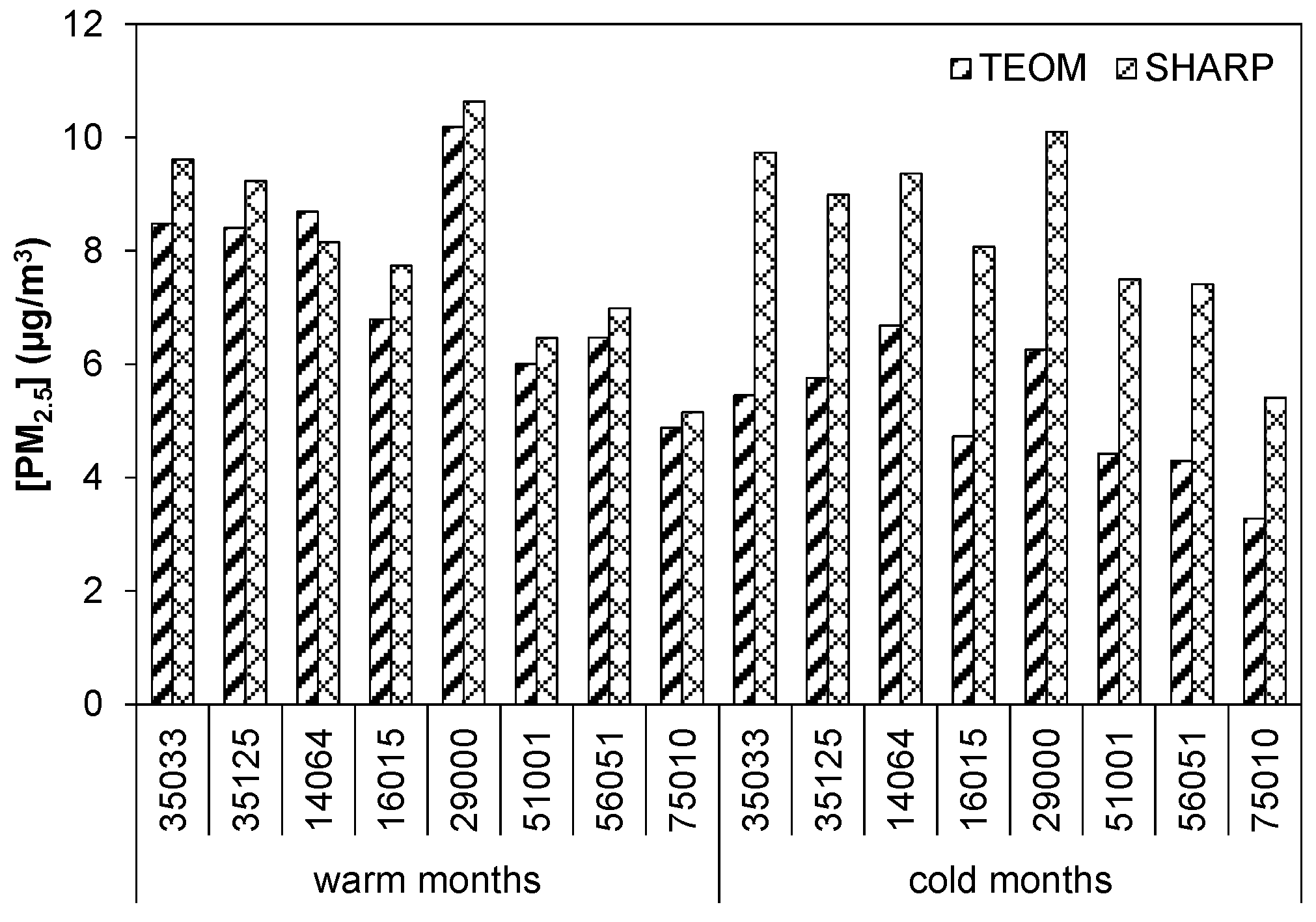
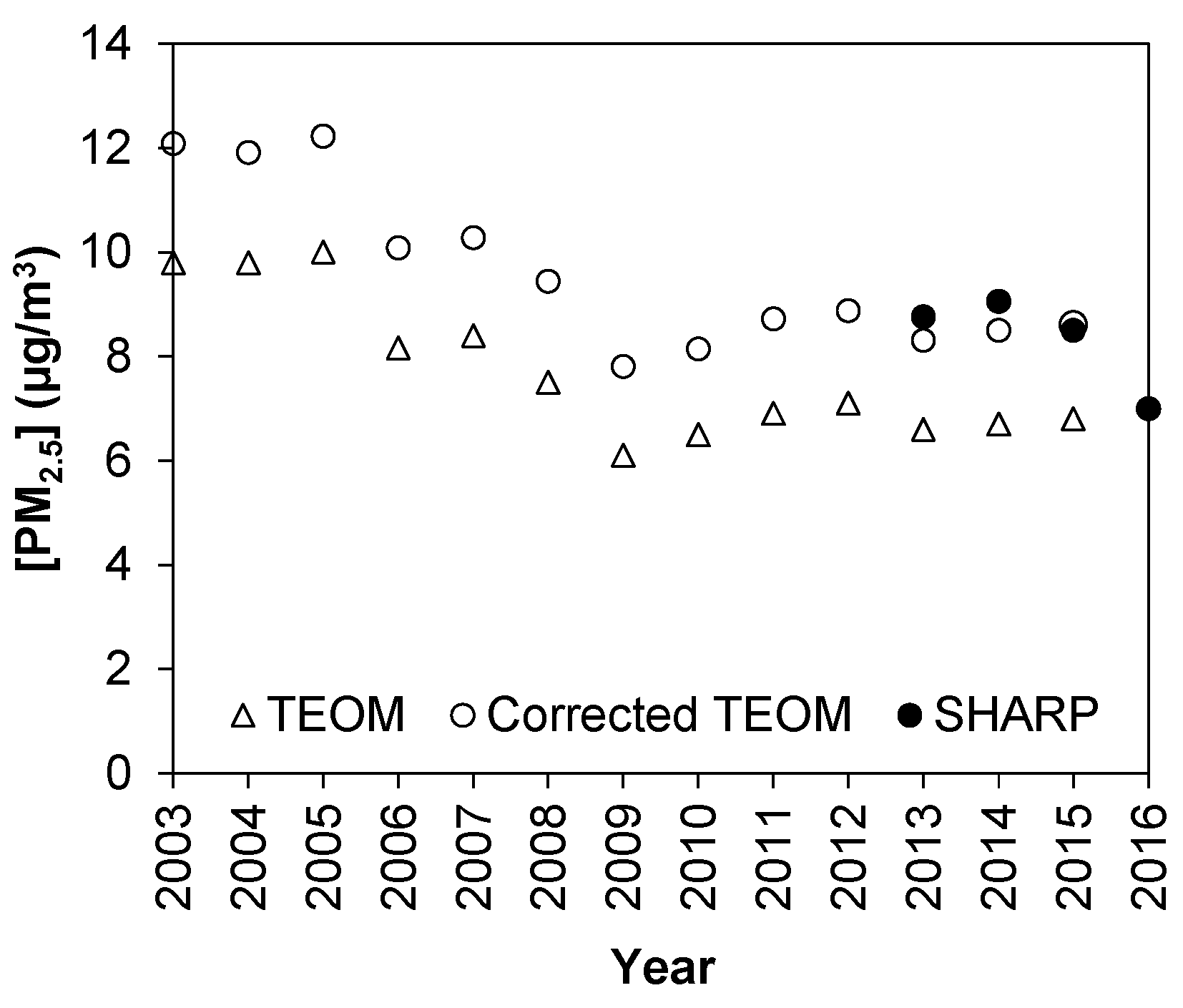
| Station ID | Station Name | FRM (Thermo Partisol 2000) | FEM Dichot (Thermo Partisol 2025) | Speciation Sampler (Met One SASS or Partisol 2300) |
|---|---|---|---|---|
| 12016 | Windsor West | NA | 6-day | 3-day |
| 22071 | Simcoe | NA | 6-day | 3-day |
| 29000 | Hamilton | NA | 6-day | 3-day |
| 35033 | Etobicoke South | NA | 6-day | NA |
| 35125 | Toronto West | 6-day | NA | NA |
| 51001 | Ottawa Downtown | NA | 6-day | 3-day |
| Station ID | Station Name | Valid Data Percentage (%) | |||
|---|---|---|---|---|---|
| 2013 | 2014 | 2015 | 2016 | ||
| 12008 | Windsor Downtown | 96 | 98 | 100 | 100 |
| 12016 | Windsor West | 95 | 100 | 98 | 100 |
| 13001 | Chatham | 98 | 98 | 97 | 98 |
| 14064/14110/14111 | Sarnia | 100 | 99 | 98 | 100 |
| 15020 | Grand Bend | 97 | 99 | 98 | 99 |
| 15026 | London | 97 | 98 | 99 | 98 |
| 16015 | Port Stanley | 99 | 93 | 98 | 98 |
| 18007 | Tiverton | 84 a | 98 | 98 | 97 |
| 21005 | Brantford | 96 | 99 | 99 | 99 |
| 26060 | Kitchener | 98 | 97 | 97 | 97 |
| 27067 | St. Catharines | 95 | 99 | 99 | 92 |
| 28028 | Guelph | 97 | 98 | 98 | 98 |
| 29000 | Hamilton Downtown | 98 | 100 | 100 | 99 |
| 29114 | Hamilton Mountain | 95 | 99 | 98 | 100 |
| 29118 | Hamilton West | 97 | 100 | 99 | 99 |
| 31103 | Toronto Downtown | 97 | 100 | 100 | 98 |
| 33003 | Toronto East | 99 | 99 | 99 | 98 |
| 34020 | Toronto North | 99 | 98 | 100 | 98 |
| 35125 | Toronto West | 96 | 99 | 98 | 99 |
| 44008 | Burlington | 99 | 99 | 99 | 100 |
| 44017 | Oakville | 99 | 100 | 95 | 99 |
| 45026 | Oshawa | 99 | 99 | 98 | 98 |
| 46089 | Brampton | 98 | 99 | 99 | 98 |
| 46108 | Mississauga | 98 | 99 | 98 | 99 |
| 47045 | Barrie | 98 | 99 | 99 | 99 |
| 48006 | Newmarket | 100 | 99 | 99 | 100 |
| 49005 | Parry Sound | 97 | 96 | 98 | 98 |
| 49010 | Dorset | 99 | 98 | 98 | 97 |
| 51001 | Ottawa Downtown | 98 | 98 | 99 | 99 |
| 51002 | Ottawa Central | 99 | 96 | 98 | 97 |
| 51010 | Petawawa | 99 | 99 | 97 | 100 |
| 52022/52023 | Kingston | 96 | 99 | 99 | 99 |
| 54012 | Belleville | 99 | 100 | 96 | 99 |
| 56010 | Morrisburg | 98 | 99 | NA b | NA b |
| 56051 | Cornwall | 98 | 99 | 98 | 99 |
| 59006 | Peterborough | 98 | 99 | 99 | 97 |
| 63203 | Thunder Bay | 100 | 94 | 100 | 98 |
| 71078 | Sault Ste. Marie | 99 | 98 | 96 | 99 |
| 75010 | North Bay | 97 | 98 | 98 | 100 |
| 77233 | Sudbury | 99 | 99 | 100 | 99 |
| Slope | Intercept | r | Count | Ratio (FEM/FRM) | |
|---|---|---|---|---|---|
| All data | 0.92 | 1.2 | 0.94 | 207 | 1.1 |
| 2013 | 0.91 | 1.9 | 0.95 | 51 | 1.1 |
| 2014 | 0.82 | 2.0 | 0.94 | 47 | 1.1 |
| 2015 | 0.98 | 0.4 | 0.93 | 56 | 1.0 |
| 2016 | 0.90 | 0.9 | 0.94 | 53 | 1.0 |
| Spring | 0.99 | 1.0 | 0.94 | 55 | 1.1 |
| Summer | 0.85 | 1.2 | 0.95 | 49 | 1.0 |
| Fall | 1.1 | −0.20 | 0.92 | 49 | 1.1 |
| Winter | 0.87 | 1.7 | 0.96 | 54 | 1.1 |
| Station ID | Station Name | Time Period |
|---|---|---|
| 14064 | Sarnia | June 2012–December 2015 |
| 16015 | Port Stanley | July 2012–December 2015 |
| 29000 | Hamilton Downtown | June 2012–December 2015 |
| 35033 | Etobicoke South | May 2009–December 2015 |
| 35125 | Toronto West | February 2011–December 2015 |
| 51001 | Ottawa Downtown | September 2012–December 2015 |
| 56051 | Cornwall | June 2012–December 2015 |
| 75010 | North Bay | July 2012–December 2015 |
© 2018 by the authors. Licensee MDPI, Basel, Switzerland. This article is an open access article distributed under the terms and conditions of the Creative Commons Attribution (CC BY) license (http://creativecommons.org/licenses/by/4.0/).
Share and Cite
Su, Y.; Sofowote, U.; Debosz, J.; White, L.; Munoz, A. Multi-Year Continuous PM2.5 Measurements with the Federal Equivalent Method SHARP 5030 and Comparisons to Filter-Based and TEOM Measurements in Ontario, Canada. Atmosphere 2018, 9, 191. https://doi.org/10.3390/atmos9050191
Su Y, Sofowote U, Debosz J, White L, Munoz A. Multi-Year Continuous PM2.5 Measurements with the Federal Equivalent Method SHARP 5030 and Comparisons to Filter-Based and TEOM Measurements in Ontario, Canada. Atmosphere. 2018; 9(5):191. https://doi.org/10.3390/atmos9050191
Chicago/Turabian StyleSu, Yushan, Uwayemi Sofowote, Jerzy Debosz, Luc White, and Anthony Munoz. 2018. "Multi-Year Continuous PM2.5 Measurements with the Federal Equivalent Method SHARP 5030 and Comparisons to Filter-Based and TEOM Measurements in Ontario, Canada" Atmosphere 9, no. 5: 191. https://doi.org/10.3390/atmos9050191




